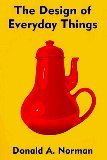One of the most influential books I have ever read is Donald Norman's "The Design of Everyday Things".
In the book, Norman rails against the usability flaws which seek to undermine our comfort and sanity. Everything from lightswitches which never seem to have a consistent state, to to alarm clocks with impossible to figure out controls. It really is a must read for anyone who cares about usability - on computers or in the real world.
I travel a lot for business - and occasionally for pleasure - so I get to experience some of the maddening issues which Norman describes fairly regularly. Nowhere is this more apparent than hotel rooms.
Hotels From Hell
I'm not talking cockroach infested flea pits with constant building works and mouldy bathrooms - although I've seen a fair few of those - but irritations which confuse, confound and exasperate a weary traveller. TVs with seemingly no volume control. Light switches which operate lamps on the other side of the room. Door locks which require an engineering degree to operate. Thermostats which either leave the room freezing or baking. All pretty trivial, yes - but of immense frustration to a jet-lagged guest who just wants to turn the lights off and sleep in a warm room.
Bathroom Blunders
The area which seems to cause me the most confusion is the bathroom. We've all experienced the shock of using someone else's shower and having them patiently explain what the trick is of turning it on - or getting it to spurt out hot water... but not too hot. Hotels, sadly, rarely come with a guide to using their facilities.
I want to point out an "interesting" usability flaw I noticed on a recent trip to Paris.
Hot Cold Confusion
What would you expect this tap to do?
The blue / cold symbol is over the spigot - surely that means activating the tap will pour cold water?
However, our experience indicates that turning a tap to the left brings forth hot water - that's the convention in my country. Is it the same in France?
There are no arrows to indicate how turning the tap will affect temperature.
We could experiment - but most people don't want to waste time with that. They just want a clear indication of what a piece of equipment will do.
So, we have an impasse. The law of proximity would indicate that two things next to one and other have a relationship. The cold symbol is next to the tap - therefore the tap will run cold.
The law of experience tells us that turning a tap to the left gives hot water.
There is no way to reason this out. We have to go through an annoying - and possibly painful - experiment to see how this mundane piece of equipment works.
Lessons
The lessons for computer and real-world usability should be clear. Don't make the user think. Don't mess with their expectations. Don't overload conventional actions with your specific action. Try to see every aspect of your project as though you were a brand new user who is unskilled in the ways of your project and of your culture.
Above all, remember that some of your users are likely to be jet-lagged and just want the simplest, easiest way to perform an action.
You can buy The Design of Everyday Things from all good bookshops.


One thought on “The Design Of Everyday Hotel Rooms”
Badly designed taps and shower taps seem to harass me far too often in the UK.
Maybe it's better you name and shame some manufacturers and models and praise some good ones.